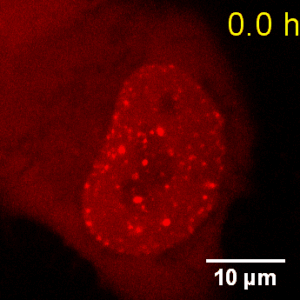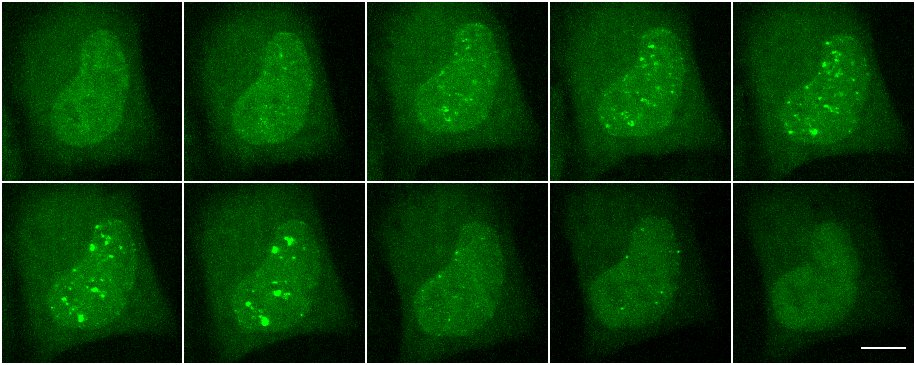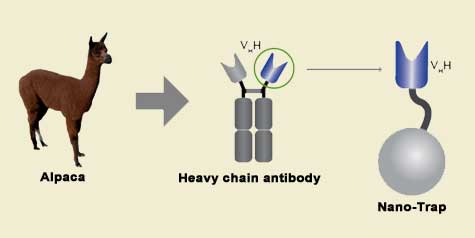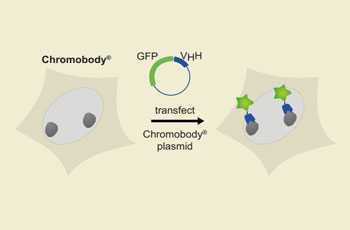Dnmt1 Chromobody Immunodetection Vector
Antibody Detection within Living Cells
A non-invasive way to visualize DNA methylation dynamics in live cells
A new tool for detection of DNA methyl-transferase in live cells, Dnmt1 Chromobody Immunodetection Vector, lets you monitor the enzyme involved with active methylation directly within the nucleus of a live cell in real time. DNA methylation is a crucial part of normal development and cellular differentiation in higher organisms. This process stably alters the gene expression pattern in cells. Such changes are “remembered” by the cell and may increase or decrease gene expression. Research has clearly shown that Dnmt1, the major eukaryotic DNA methyl-transferase, faithfully maintains genome-wide methylation patterns and plays an essential role in the epigenetic network – controlling gene expression and genome stability during development.
The small size of the Dnmt1 Chromobody produces a high signal-to-noise ratio for stunning, high resolution images or time lapsed movies of the chromatin methylation dynamics. Remarkably, it has no influence on methylation patterns and exhibits extremely low toxicity of most cell types. Simply transfect the cell line of your choice with the Dnmt1 Chromobody plasmid. This plasmid contains the sequence of an Dnmt1-specific alpaca antibody fused to TagRFP or TagGFP (Evrogen). Upon transformation, your cells will express the Dnmt1 Chromobody. The cell’s nuclei will fluoresce diffuse and punctate patterns as the fluorescent Chromobody molecules specifically localize to DNA methyl-transferase. This transient binding does not influence cell viability or gene expression pattern and thus offers you a unique possibility to observe the sites of methylation directly on the chromatin.
Live visualization of Dnmt1 Chromobody in cells
HeLa cells were transfected with the Dnmt1-Chromobody plasmid and observed during growth and division. The cells were imaged every 30 minutes for 24 hours. The anti-Dnmt1-TagRFP Chromobody binds DNA methyl-tranferase with the cell nucleus. In G phase cells the signal is homogeneously distributed through the nucleus and cytoplasm. Over time during S phase granules appear in the nucleus as replication foci form, finally the granularity disappears and the cells divide.

Still images of Dnmt1-Chromobody transfected HeLa cells throughout the cell cycle. This time, using an anti-Dnmt1-TagGFP fusion, formation of replication foci can be seen as bright green dots, as the cells progress through S-Phase. The Dnmt1-Chromobody does not affect normal cell function.

Chromobodies turn your cells into immuno-reporter factories
Nanobodies are unique, small antibody fragments that exhibit the extraordinarily efficacious binding of a targeted protein. Expressed in animal cells, Nanobodies can be collected and used for in vitro studies. Something unexpected happened when Nanobodies were expressed as a fusion to a reporter molecule such as GFP. The newly formed Chromobody bound directly to its target within the cells in which it was being made. Moreover, using the correct vector and promoters, the binding has both high specificity and low background. This provides an excellent alternative to GFP-fusions with the protein of interest for immuno-localization studies. Why? Because GFP- and RFP-fusions have been shown to block or alter the activity of the fused protein. In contrast, Chromobody act in trans as a reporter that will not interfere with the normal function of the targeted protein.

Camelidae single-domain antibodies are like IgGs on steroids
The family of animals known as Camelidae (camels, llamas, and alpacas) produce functional antibodies devoid of light chains, so-called "heavy chain" antibodies. These heavy chain antibodies recognize and bind their antigens via a single variable domain. When cleaved from their carboxy tail, these barrel-shaped structures (2x3 nm) are extraordinarily small, naturally-occurring, and intact antigen binding fragments (MW of 13 kDa). These fragments, called Nanobodies, are characterized by high specificity, affinities in the low nanomolar range, and dissociation constants in the sub-nanomolar range (typically 10- to 100-fold better than mouse IgGs). The compact size of Nanobodies makes them extremely stable at temperatures up to 70°C, and functional even in 2M NaCl or 0.5% SDS. These small and powerful antibody fragments can be used in a variety of unique applications. They will open up your research possibilities.
Dnmt1 Chromobody Immunodetection Vector
|
SPECIFICATIONS
|
|
|---|---|
| Part Numbers | DCBRFP, DCBGFP, dcg, dcr |
| Vector Type | Mammalian expression vector encoding the cell cycle marker Dnmt1-VHH fused to green fluorescent protein TagGFP2 or TagRFP |
| Target Molecule | Endogenous Dnmt1 |
| Reporter | TagGFP2 or TagRFP (from Evrogen) |
| Host Cells | Mammalian |
| Transfection Method | Transfect mammalian cells by any known transfection method. If required, stable transformants can be selected using G418 [Gorman 1985] |
| Propagation in E. coli | DH5alpha, HB101, XL1-Blue, and other general purpose strains
Incompatible with pMB1/ColE1 |
| Selection | Prokaryotic – kanamycin
Eukaryotic – neomycin (G418) |
| Replication | Prokaryotic – pUC ori
Eukaryotic – SV40 ori |
| Use | Non-invasive live cell visualization of DNA methylation |


